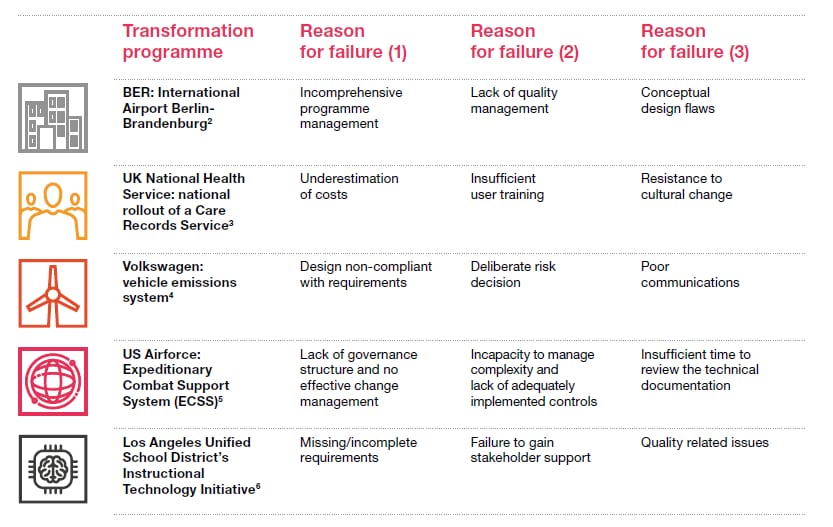{{item.title}}
{{item.text}}

{{item.title}}
{{item.text}}
12/10/23
Marc Lahmann
Partner, Strategy & Transformation
PwC Switzerland
Adrian Stierli
Senior Manager, Strategy & Transformation
PwC Switzerland
In this post we share a few tips from our practice on how to prevent expensive, large-scale transformation projects from failing ‒ and how to rescue them if they threaten to veer off track.
PwC’s Global Programme Management Survey found that half of all projects fail or exceed their budget. Sobering, isn’t it? But hardly surprising given that the same survey revealed that 71% of companies have projects not driven by strategy. Here are some prominent (and in some cases spectacular) examples:
Having examined the root causes of failures like this, we at PwC have identified five influencing forces. These five forces don’t exist in isolation. It’s crucial to understand and manage the way their dynamics are reinforced to put a project in jeopardy.
In our experience, it’s crucial to have a proper setup and room for flexibility, especially when it comes to complex transformation initiatives in an environment of change.
To increase the chance of transformation success it’s important to achieve maximum transparency. This means adopting a layered approach, starting at the project and work-stream level and moving through to project management functions towards an independent external view.
«Unfortunately, today’s business environment is characterised by an increased necessity for change and an ever greater volume of resulting programmes and projects. Transformation initiatives have become larger and more complex, and investment volumes are increasingly continuously. However, success rates have not increased correspondingly; on the contrary, they are even declining.»
The first question to ask is whether it’s really in trouble, or whether it’s simply a sticky phase. Sometimes trouble can arise spontaneously. But in many cases it emerges slowly. If you’ve understood the five forces and have been keeping an eye on expected outcomes, it’ll be easier to discern whether the project really is in trouble.
The success and failure of projects have traditionally been measured in terms of “the iron triangle”: budget, schedule and scope. But in today’s environment you need to take a broader view that also considers project value and the realisation of business benefits, the management of stakeholder expectations, and an understanding of the perception stakeholders have of project success and organisational readiness to enable acceptance.
Whatever the case, rescuing a project requires an experienced team willing to react quickly, and leadership prepared to make decisions. Avoid taking action for action’s sake, treating the situation as a fire drill or only focusing on the superficial symptoms to the exclusion of the real underlying issues. What you need is a structured approach, starting with stabilising the project on the basis of the visible symptoms, and proceeding to do an in-depth root cause analysis as the basis for defining a recovery plan. Here are some key steps to take:
The success of a programme or project depends on how project management, project teams and sponsors manage problematic project phases by focusing on the fundamental root causes rather than superficial symptoms. To enable this to happen it’s helpful to put clear recovery governance in place. This includes defining a recovery sponsor and a dedicated project rescue team. Continuous project health checks will enable you to identify trouble at all stages within the life cycle and keep projects on track.
Given the complexity and pressure of large-scale transformation projects, it’s no wonder many of them get into trouble. By understanding and managing a small number of common root causes and how these forces interact dynamically, you can prevent trouble in the first place or move effectively to rescue the project once trouble strikes.
At the Global Summit 2023 Marc Lahmann and Adrian Stierli spoke on the topic of “Are large-scale transformation initiatives doomed by default?”. The session handout is now available below.
2 http://www.newstatesman.com/business/2013/09/curious-case-berlins-brandenburg-airport
3 https://www.theguardian.com/society/2013/sep/18/nhs-records-system-10bn
4 http://business.financialpost.com/news/transportation/putting-a-price-on-volkswagens-emission-fraud-mess-its-going-to-cost-them-billions
5 http://www.computerworld.com/article/2493041/it-careers/air-force-scraps-massive-erp-project-after-racking-up--1b-in-costs.html
6 http://www.wired.com/2015/05/los-angeles-edtech/
#social#


Adrian Stierli
Senior Manager, Strategy & Transformation, PwC Switzerland
Tel: +41 58 792 21 69



